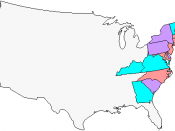Jeffersonians vs. Federalists
During the period of 1801-1817, the Jeffersonians and the Federalists were viewed differently when it came to the federal Constitution. The Jeffersonians were viewed as strict constructionists and the Federalists were more of a group of loose constructionists. Although the two parties had their different views on the federal government, they occasionally switched their views to help solve certain situations.
The Federalists, led by Alexander Hamilton, were "laid back" when it came to their interpretation of the Constitution. The Federalists seemed to ignore the poor people. It was as if the higher people didn't have much faith in the common folk. They had passed tariffs and taxes to help private businesses. The Federalists wanted to hear and talk with the people who had money. The Federalists wanted the "best people" to rule. Federalist John Lay stated that "those who own the country, ought to govern it." Despite all this, the Federalists did believe in a very strong central government and a powerful central bank.
Their goal was to protect the wealthy people. The Hartford Convention, which lasted from late December to early January, was an event that hurt the Federalist Party. The two results to the Hartford Convention were: Washington had to provide financial aid from lost trade and that two-thirds vote in Congress was required before an embargo could be passed. The Federalists were proud of how they supported only the wealthy, because they believed that this lead to a powerful central government.
Thomas Jefferson led the strict constructionists, Democratic-Republicans, also known as, the Jeffersonians. The Jeffersonians didn't have that strong of a central government. Jefferson believed that the best government was the one that wasn't governed often, so that the states received more power and independence. To them, the power should stay within the states.



My feelings about your paper
The term, "as listed above" should not be there. I feel that the idea wasn't flowing freely and a few ideas brought into the paper came without explanation. You should try to write as though the person reading has no idea. Writing very descriptively and to the point is a fine art, however you are on your way.
A certain sentence struck me in this paper. "From a Federalists point of view, Daniel Webster was outraged at Madison over a conscription bill". I am hoping I didn't mess anything up in that quote. Now from my point of view, without prior knowledge of Daniel Webster, you would have lost me. Who is he? Where does he come in? Why hasn't he been mentioned already if he is a key player in your paper?
Maybe you should consider revising these few items, unless your paper is perfect to your teacher's specifications.
Mariah
Pre-Doctoral Student
Double Majoring in Nursing and Psychology
Peace
0 out of 0 people found this comment useful.